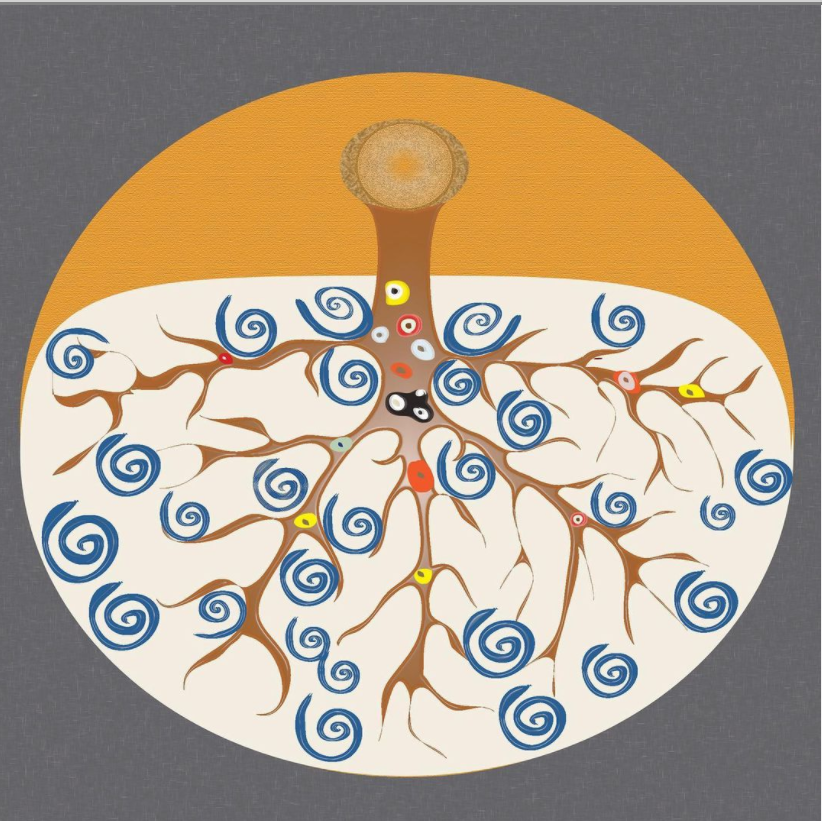SciArt profiles: Justine Renno
Posted by the Node Interviews, on 22 January 2021
The second in our new series of SciArt profiles features Justine Renno, a Master’s student in Bordeaux.

Where are you originally from, where do you work now, and what do you work on?
I am originally from Alsace in France. I got a Master’s in developmental biology which I ended with a 6 months internship at EMBL in Heidelberg. This successful internship and the interesting Masters courses led me to pursue a Ph.D. at the Institute of Science and Technology in Austria at IST Austria.
Unfortunately this Ph.D. had to end prematurely due to emergency brain surgery I had to undergo in the third year. but at the same time as doing my Ph.D., IST Austria had given me the opportunity to discover the exciting field of science communication. The experiences I took part in made me realize that this was the job I wanted to do, and therefore I decided to enrol in another program to get the set of skills needed in science communication.
I am currently in the process of getting a Master’s degree from the University of Bordeaux Montaigne in France. Because I want to help to bridge the gap between research and innovation, I’ll do a 6 months internship at the scientific research and innovation board of Loreal.
Were you always going to be a scientist?
Science was my first love. From very early on I was fascinated by the biological processes which govern life. I couldn’t imagine myself feeling as happy and useful in any other discipline. So I hesitated for a long time before commuting from academia to science communication but this change has been really positive so far and allows me to keep updated with scientific discoveries in various fields. It is very rewarding.
And what about art?
I started drawing at a very young age, mainly drawing my favourite animals, especially horses and dogs. In recent years I started making illustrations for the new papers of my fellow colleagues. I really enjoy conveying scientific discoveries through art. Asking questions and listening to the scientists somehow triggers my artistic imagination in a way that I always end up having tons of illustration ideas.
“I really enjoy conveying scientific discoveries through art”
What or who are your artistic influences?
I love surrealism, and artists such as Salvador Dali, Yves Tanguy, René Magritte and Frida Kahlo.
How do you make your art? How do you approach making a new piece of art?
I used to start with a simple pencil and paper but after a few years of experience with numerical drawing, I directly started drawing on my tablet or my laptop with the touchpad. I start with a broad idea, a drafty sketch, which I turn very dim in the background. I draw a more realistic vision on top of it with larger and darker brushes, making use of many layers on top of each other to go more in detail.
Does your art influence your science at all, or are they separate worlds?
Science certainly influences my art. I love to make illustrations of beautiful data, something catchy which attracts the reader’s attention. Nature is so perfect and beautiful, it’s a never-ending source of inspiration.



The illustration shows a spider web with water droplets resembling ZO-1 droplets interacting with the filamentous actin network close to tight junctions. A gastrulating zebrafish embryo is placed in the centre of the web to illustrate the process of epithelial spreading, for which tight junction mechanosensitivity—brought about by ZO-1 phase separation and flow—is required. © Justine Renno/ IST Austria

Figure panels made for a review of the biophysical mechanisms by which the cytoskeleton drives cytoplasmic reorganization across different scales, structures, and species. © Justine Renno/ IST Austria

We’re looking for new people to feature in this series throughout the year – whatever kind of art you do, from sculpture to embroidery to music to drawing, if you want to share it with the community just email thenode@biologists.com (nominations are also welcome!).


 (8 votes)
(8 votes)
Beautiful artwork!